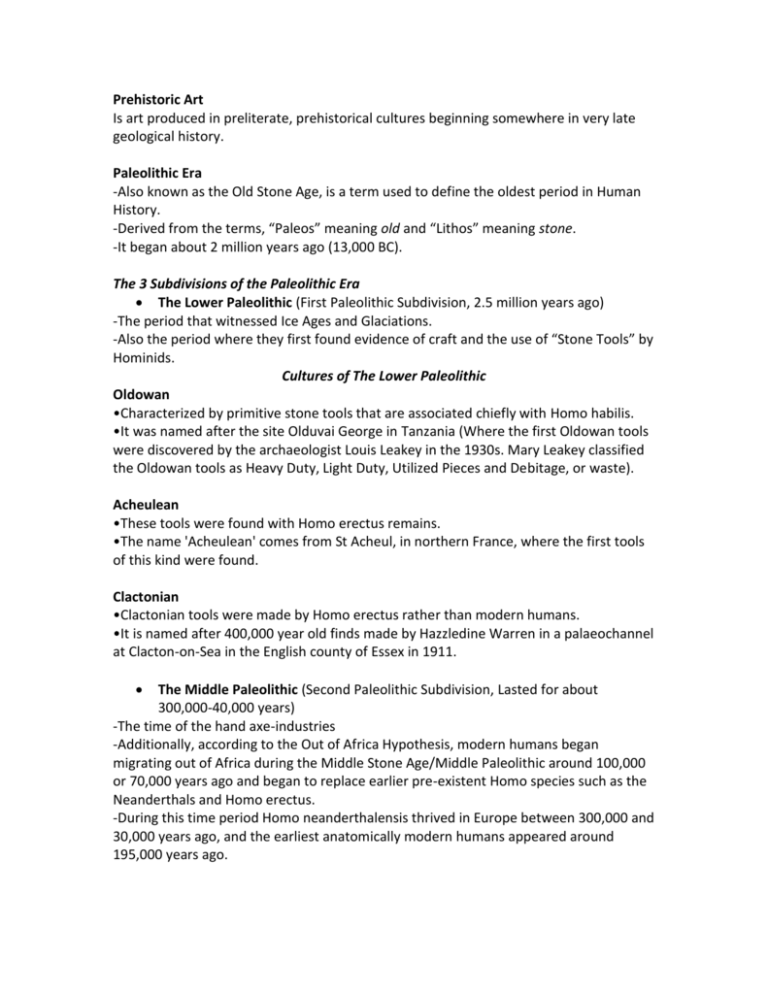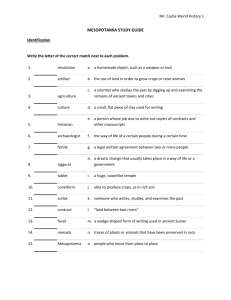Prehistoric Art - Portia Placino
advertisement

Prehistoric Art Is art produced in preliterate, prehistorical cultures beginning somewhere in very late geological history. Paleolithic Era -Also known as the Old Stone Age, is a term used to define the oldest period in Human History. -Derived from the terms, “Paleos” meaning old and “Lithos” meaning stone. -It began about 2 million years ago (13,000 BC). The 3 Subdivisions of the Paleolithic Era The Lower Paleolithic (First Paleolithic Subdivision, 2.5 million years ago) -The period that witnessed Ice Ages and Glaciations. -Also the period where they first found evidence of craft and the use of “Stone Tools” by Hominids. Cultures of The Lower Paleolithic Oldowan •Characterized by primitive stone tools that are associated chiefly with Homo habilis. •It was named after the site Olduvai George in Tanzania (Where the first Oldowan tools were discovered by the archaeologist Louis Leakey in the 1930s. Mary Leakey classified the Oldowan tools as Heavy Duty, Light Duty, Utilized Pieces and Debitage, or waste). Acheulean •These tools were found with Homo erectus remains. •The name 'Acheulean' comes from St Acheul, in northern France, where the first tools of this kind were found. Clactonian •Clactonian tools were made by Homo erectus rather than modern humans. •It is named after 400,000 year old finds made by Hazzledine Warren in a palaeochannel at Clacton-on-Sea in the English county of Essex in 1911. The Middle Paleolithic (Second Paleolithic Subdivision, Lasted for about 300,000-40,000 years) -The time of the hand axe-industries -Additionally, according to the Out of Africa Hypothesis, modern humans began migrating out of Africa during the Middle Stone Age/Middle Paleolithic around 100,000 or 70,000 years ago and began to replace earlier pre-existent Homo species such as the Neanderthals and Homo erectus. -During this time period Homo neanderthalensis thrived in Europe between 300,000 and 30,000 years ago, and the earliest anatomically modern humans appeared around 195,000 years ago. Cultures of the Middle Paleolithic Era Mousterian •Predominantly flint tools (or industry) associated primarily with Homo neanderthalensis. •It was named after the type site of Le Moustier, a rock shelter in the Dordogne region of France. •Mousterian tools that have been found in Europe were made by Neanderthals and date from between 300,000 BP and 30,000 BP. Aterian •The industry was probably created by modern humans (Homo sapiens), albeit of an early type, as shown by the few skeletal remains on the Moroccan Atlantic coast. The Upper Paleolithic (40,000 and 8,500 years ago) -Characterized by the emergence of regional stone tool industries such as the Perigordian, Aurignacian, Solutrean, and Magdalenian of Europe, as well as other localized industries of the Old World and the oldest known cultures of the New World. -The tools typical of this period were made from very long, thin flakes of stone (blades) and fashioned from materials like bone, antler, ivory, and wood. -Innovations and Developements: a)The appearance of the first anatomically modern humans in Europe b)More complicated structures c)Further plant and animal use d)Elaborate burials e) Global migration f)The beginnings of trade g)Widespread use of stone blades h)innovative new tools like the atlatl and bow and arrow i)The domestication of the dog, j)The appearance of art and decoration Cultures of the Upper Paleolithic Era Baradostian (36,000 BC) -Is an early Upper Palaeolithic flint industry culture in Zagros region at the border of Iran and Iraq. Châtelperronian (c. 35,000 and c. 29,000 BP) -During this period most of the tools were made from stone flakes, thin, sharp pieces of flint. -This industry produced denticulate, or toothed, stone tools and also a distinctive flint knife with a single cutting edge and a blunt, curved back. Aurignacian (34,000–29,000 years ago) -This was named after the type site of Aurignac in the Haute Garonne area of France. -The Aurignacian tool industry is characterized by worked bone or antler points with grooves cut in the bottom. -The people of this culture also produced some of the earliest known cave art, such as the animal engravings at Aldène in southwest France. Gravettian (28,000–19,000 years ago) -It is named after the type site of La Gravette in the Dordogne region of France where its characteristic tools were first found and studied. -A phase distinguished by particular tool types, especially backed blades and points. -The diagnostic characteristic artifacts of the industry are small pointed restruck blade with a blunt but straight back, a carving tool known as a Noailles burin. Solutrean (21,000–18,000 years ago) -It is named after the type-site of Crôt du Charnier at Solutré in the Mâcon district, eastern France, and appeared around 19,000 BCE. -The Solutrean has relatively finely worked, bifacial points made with Lithic reduction percussion and pressure flaking rather than cruder flint knapping. Magdalenian (17,000 BP to 9,000 BP) -It is characterized by a range of bone and horn tools, and by highly developed cave art. -It was named after the type site of La Madeleine, a rock shelter located in the Vézère valley, commune of Tursac, in the Dordogne department of France. Hamburg (13,500-11,100 BC) -Culture of reindeer hunters in northwestern Europe during the last part of the Weichsel Glaciation and beginning of the Meiendorf Interstadial. -It is characterized by shouldered points and zinken tools, which were used as chisels when working with horns. Ahrensburg -The culture is named after village of Ahrensburg, 25 km (16 mi) northeast of Hamburg in the German state of Schleswig-Holstein where wooded arrow shafts and clubs have been excavated. -Three important settlements during this time: a.) Meiendorf b.) Stellmoor c.) Bomeck Swiderian •It was named after the type site Świdry Wielkie, in Otwock. •It is recognized as a distinctive culture that developed on the sand dunes left behind by the retreating glaciers. Mesolithic Era -Derived from the greek words mesos which means “middle” and lithos which means “stone.” -Is the period of Middle Stone Age, from about 10,000 - 5,000 BC years ago. -It corresponds to the period of primarily nomadic hunting and gathering which preceded the adoption of domesticated plants and animals. Cultures of the Mesolithic Era •Azilian culture •Lepenski Vir culture •Balkan mesolithic cultures •Maglemosian culture •Capsian culture •Natufian culture •Fosna-Hensbacka culture •Neman culture •Harifian culture •Nøstvet and Lihult cultures •Kebaran culture •Sauveterrian culture •Jōmon cultures •Tardenoisian culture •Jeulmun culture •Zarzian culture •Komsa culture •Kongemose culture •Kunda culture Notable Sites during the Mesolithic Era •Lepenski Vir, Serbia (7000 BC) •Newbury, England •Star Carr, England and Star Carr house •Swifterbant culture, The Netherlands (8700 BC) •Aveline's Hole, Somerset, England •Pulli settlement, Estonia (9000 BC) (8000 BC) •Franchthi cave, Greece (20,000–3000 •Ngwenya Mine, Swaziland (42,000 BC) BC) •Nanzhuangtou bog, China (8500-7700 •Cramond, Scotland (8500 BC) BC) •Mount Sandel, Ireland (7010 BC) •Rock Shelters of Bhimbetka, India •Howick house, England (7000 BC) •Shigir Idol, Russia (7500 BC) Neolithic Era -The New Stone Age, began when men first developed agriculture and settled in permanent villages. -The prime medium of Neolithic art was Pottery. -Free standing sculpture had already begun by the Neolithic, the earliest being the anthropomorphic figurines. -Pottery Phases: •Neolithic 1 – Pre-Pottery Neolithic A (PPNA) •Neolithic 2 – Pre-Pottery Neolithic B (PPNB) •Neolithic 3 – Pottery Neolithic (PN) Terminologies Megalith- is a large stone that has been used to construct a structure or monument, either alone or together with other stones. Derived from the words megas meaning “great” and lithos meaning “stone. Cupules- are the earliest known prehistoric art, have been found on every continent except Antarctica, and were produced during all three eras of the Stone Age Paleolithic, Mesolithic and Neolithic - as well as in historical times. The term “Cupule” was invented by the world famous archaeologist Robert G. Bednarik. Petroglyph- was derived from the greek terms, petros meaning “rock” and glyphein meaning “carve.” It simply means, rock carving. Ochre- is a naturally occurring red iron oxide, commonly used by prehistoric huntergatherers as a coloring pigment for body-painting. Mythological Figures in Greek Mythology Aphrodite- Goddess of love, beauty and sex. Apollo- God of music, healing, plague, prophecies, poetry, and archery; associated with light, truth and the sun. Ares- God of war, bloodlust, violence, manly courage, and civil order. Artemis- Virgin goddess of the hunt, wilderness, wild animals, childbirth and plague. Athena- Goddess of wisdom, warfare, battle strategy, heroic endeavour, handicrafts and reason. Demeter- Goddess of agriculture, horticulture, grain and harvest. Dionysos- God of wine, parties and festivals, madness, civilization, drunkenness and pleasure at forever young. Hades (Pluto)- King of the Underworld and god of the dead and the hidden wealth of the Earth. Hephaestus- Crippled god of fire, metalworking, stonemasonry, sculpture and volcanism. Hera- Queen of marriage, women, childbirth, heirs, kings and empires. Hermes- God of travel, messengers, trade, thievery, cunning wiles, language, writing, diplomacy, athletics, and animal husbandry. Hestia- Virgin goddess of the hearth, home and cooking. She is a daughter of Rhea and Cronus and sister of Zeus. Poseidon- God of the sea, rivers, floods, droughts, storms, earthquakes, and the creator of horses; known as the "Earth Shaker" or "Storm Bringer". Zeus- The king of the gods, the ruler of Mount Olympus and the god of the sky, weather, thunder, law, order, and fate.








